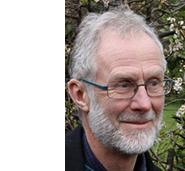
During his talk on November 20, London-based museum and heritage consultant Crispin Paine introduced an intriguing idea: in a secular society, have museums become, in their own way, temples? Both visitors to museums and temples, Paine observed, follow a set route through the building and pause to reflect before certain objects. The religious visitor leaves with a renewed faith, the museum visitor with edification.
For museums that contain religious objects, as many do, the line between the secular and the spiritual is becoming increasingly hazy. “Some museums encourage acts of devotion,” Paine said, “so much so that they practically double as shrines.”
He recounted stories of Buddhist monks visiting the Buddhist art wing of a gallery in Birmingham, England, and related the experience of a group of Muslim women in Leeds, England, who upon first entering an Islamic art exhibit, insisted on performing ritual ablutions. Though perhaps not the acts of typical museum visitors, Paine suggested that viewing religious items in a museum as religious, rather than historical items, is not necessarily wrong.
How both visitors and curators interact with and respect items in museums is a tricky question, and one “perhaps better suited to a philosopher than a curator,” Paine said. It is curators, however, who are tasked with solving this issue.
“Curators have nearly absolute power over what to allow objects to say,” Paine said. This is particularly important because museums have a responsibility to explain religion to some of their visitors, particularly because “many people in the developed world may only experience religion in a museum,” according to Paine.
To that end, Paine feels that witnessing spontaneous acts of devotion in a museum context is perhaps beneficial. Observing people interacting with the religious objects in a spiritual way helps contextualize a part of a collection. It makes a simple object part of a living canvas, tying it to the current world as well as to a historical period.
Displaying religious objects in this way helps museums fulfill what many museums view as a mandate to positively impact their visitors. “Museums cannot be wholly neutral,” Paine said, so instead many are now “seeking to promote community harmony.”
Allowing people to witness the cultural and religious breadth of their communities firsthand appears to be an effective tool—research on a 2012 exhibition about the Muslim hajj at the British Museum indicated that visitors were more likely to understand and empathize with the pilgrimage’s religious significance after visiting.
The success of exhibitions at promoting community sentiment does not, however, mean that displaying religious objects in museums is uncontroversial. Various religious groups frequently petition museums to return their spiritual objects to them. Some worry that the objects may be stripped of their greater significance in a museum, some feel that these objects represent a part of their patrimony, and some feel that repatriation is a political issue.
“It seems the struggle for control of objects is a fundamental human characteristic,” Paine said. Unfortunately, however, “objects can become footballs in power plays” between two different groups and frequently within a single group.
He illustrated this point with an example of a 19th century Sikh throne in the British Museum that a group requested be returned to India just after the Indian government repressed a Sikh independence movement in the 1980s. To do so, Paine observed, would have sent a very strong political message to both Sikhs and to the Indian government.
Yet the sometimes-volatile nature of objects and the culture that surrounds them is precisely why, in Paine’s estimation, museums are so important. “The museum, at its best,” he said, “is a crucible for new ideas, a place for a three-way negotiation between object, curator and visitor.”
Posted November 21, 2013
